
I used to wear my manual WordPress work like a badge of honor.
Client needs a contact form? I’d code it by hand. New user registrations? I’d manually assign roles and send welcome emails.
SEO optimization? I’d go through each post one by one, updating the SEO Headline, tweaking meta descriptions, and checking keyword density.
Then I realized something important. Working harder doesn’t make you a better WordPress expert. Working smarter does.
After spending way too many late nights on repetitive tasks that could run themselves, I decided to test every automation plugin I could find.
Twenty-three plugins later, I discovered something game-changing. The right tools don’t just save time, they completely free up my time for more important things.
Now my sites handle SEO optimization automatically!
On top of that, forms route inquiries to the right team members without my input. While eCommerce orders process and deliver files while I sleep.
The best part is client communication happens on autopilot through smart workflows.
In this article, I will share the 8 best automation plugins that transformed how I work with WordPress.
Instead of spending hours on repetitive tasks like email marketing setup, site building, and eCommerce management, I focus on what actually grows businesses.
In a nutshell, I let the tools handle the boring stuff while I handle the strategy.
Key takeaways:
- Best overall automation: Uncanny Automator connects any WordPress plugins instantly
- My recommendation for tight budgets: AutomatorWP offers powerful open-source automation
- Best for beginners: WPForms automates form workflows with zero setup complexity
How I Test WordPress Automation Plugins
When testing automation plugins, I don’t care about fancy features that sound impressive in marketing copy. I care about whether they actually eliminate the repetitive work that eats up my day.
Here’s exactly what I look for:
- Setup Time – Can you get it working in under 30 minutes? If I need to read a manual or watch tutorials just to create my first automation, it fails this test.
- Learning Curve – Does it make sense without needing a computer science degree? The interface should feel natural, not like operating a spaceship control panel.
- Time Savings – Does it actually eliminate repetitive tasks or just move them around? I track how much time each plugin saves me per week on real client projects.
- Reliability – Does it work consistently without babysitting? Automation that breaks or needs constant tweaking isn’t automation at all.
- Integration Ease – Does it play well with other WordPress tools you’re already using? The best plugins work seamlessly with your existing setup.
Each automation plugin on this list passed these tests on actual client sites. No theoretical benefits or marketing promises. Just real-world results from someone who’s been building WordPress sites for years.
Why Trust IsItWP?
At IsItWP, we’ve been the WordPress community’s go-to resource since 2009, helping over 2 million users choose better plugins and tools.
Unlike many review sites that never actually use the products, we maintain active accounts, run real client websites, and provide ongoing WordPress consultation.
Apart from that, we test every plugin on this list with real workflows, actual client data, and genuine business scenarios.
When I say a plugin saves me hours, I mean I’ve tracked the time savings across multiple projects and can show you exactly where those hours went.
The 8 Plugins That Save Me Hours
Now that you understand my testing process and how these plugins for WordPress landed on my list, check out the comparison table for a quick glimpse to expect from the tools.
You can also click on the name of the plugin to skip to that section of the article.
Now, with that out of the way, let us dive into the article.
1. Uncanny Automator ⭐⭐⭐⭐⭐
350+ Triggers & Actions + Visual Builder | Best for: Connecting everything in your WordPress site
Pricing: Free version available; Pro plans start at $149/year
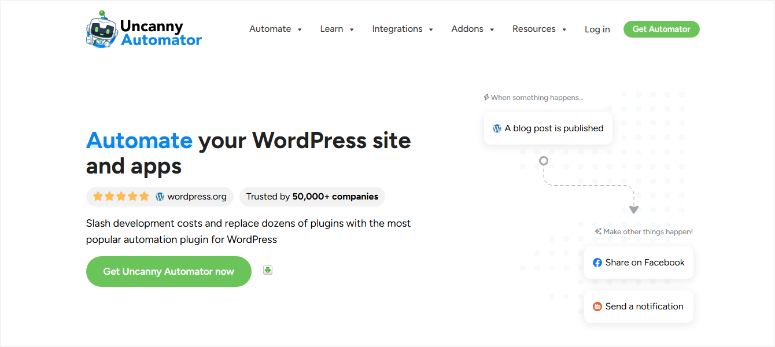

Uncanny Automator is the best automation plugin. Not only that, it is also my favorite automation plugin.
Think of Uncanny Automator as the central nervous system for your WordPress site.
It uses a simple “recipe” system where you set up triggers (when something happens) and actions (what should happen next).
For example, when someone buys Product A, Uncanny Automator can help you automatically enroll them in Course B, then add them to Mailchimp list C, and finally send them a welcome email.


You do not have to do anything yourself after the initial setup. Everything is automated using triggers from users and actions from the tool.
What makes this plugin incredible is its massive library of connections. With 210+ plugin integrations, it talks to almost every popular WordPress tool you’re already using.
For example, WooCommerce, LearnDash, BuddyPress, WPForms, and MemberPress can all work together seamlessly through Uncanny Automator’s recipe system.
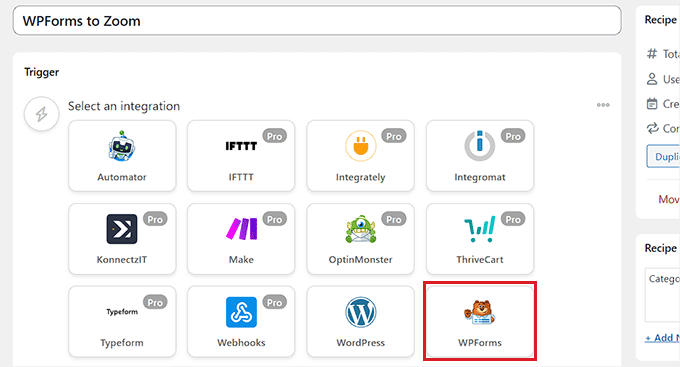

Apart from that, it is really simple to use because the visual interface makes complex workflows feel simple.
Instead of writing code or wrestling with complicated settings, you just drag and drop triggers and actions.
Plus, with 8,700+ dynamic tokens, you can personalize everything. User names, purchase details, course progress, or any data from your site can automatically populate emails, create custom user experiences, or trigger specific actions.
I’ve been using this on membership sites where new users need specific role assignments based on their purchase.
What used to take manual work now happens instantly. The best part is that the forever-free version gives you unlimited recipes, which is generous compared to most automation tools.
►Pros:
- Forever free core version with unlimited recipes and integrations
- Intuitive recipe system that makes complex automation feel simple
- Massive plugin library with 210+ WordPress integrations
- Outstanding support with 95% Help Desk Happiness rating
►Cons:
- Learning curve for complex multi-step workflows
- Pro version required for external app integrations
- No visual flow builder like some competitors
- Canadian customers pay additional sales tax
My Verdict: If you want to connect different parts of your WordPress site automatically, Uncanny Automator is the easiest and most reliable way to do it. It is perfect for membership sites, online course creation, and eCommerce stores that need everything working together.
Check out my Uncanny Automator review here.
Pricing: Free version available; Pro plans start at $149/year
2. AutomatorWP ⭐⭐⭐⭐⭐
Open-Source + 200+ Integrations | Best for: Developers and budget-conscious users
Pricing: Free version available; Pro plans start at $149/year
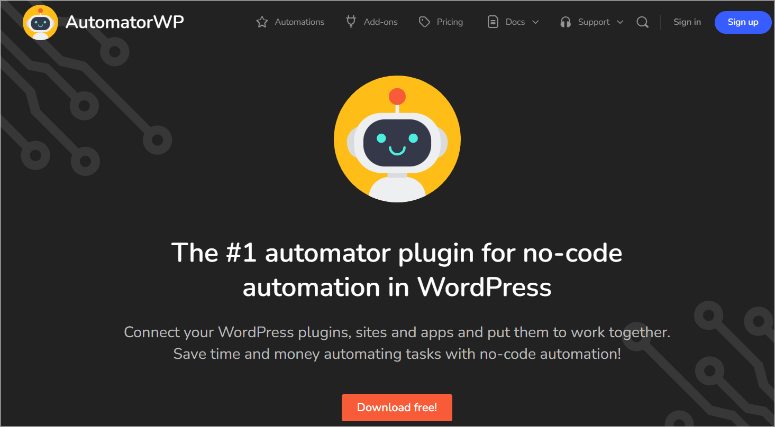

I discovered AutomatorWP when I needed Uncanny Automator’s functionality but wanted to customize everything.
This is because it’s completely open-source, which means you can modify it, extend it, and build custom integrations. But even though AutomatorWP is more flexible, it requires a bit more technical knowledge.
But on the flip side, this automation plugin uses the same trigger-action system as Uncanny Automator, but with a modular approach.
So, instead of paying for everything up front, you buy individual addons for $29 each. This approach saves money if you only need specific integrations.
For example, you can purchase AffiliateWP, WooCommerce, BuddyPress, BuddyBoss, Campaign Monitor, and any of the other 200+ addons to add functionalities.
Plus, the REST API support means you can connect external services with custom webhooks.
What I love about AutomatorWP is its solid free version available directly from WordPress.org. Unlike many competitors, the core functionality doesn’t cripple you with limitations.
You get unlimited automations, comprehensive logging, and access to basic WordPress triggers and actions.
►Pros:
- Robust free version available on WordPress.org
- Cost-effective modular pricing at $29 per add-on
- Open-source flexibility for custom modifications
- Strong 4.8/5 star rating with active community
►Cons:
- Add-on dependency for most advanced features
- Less polished interface compared to premium competitors
- Smaller support team than commercial alternatives
- Feature management across multiple add-ons can get complex
My Verdict: Perfect for developers and agencies who want automation flexibility without paying for features they don’t need. The open-source approach and modular pricing make it ideal for custom projects and budget-conscious users.
Pricing: Free version available; Pro plans start at $149/year
3. WPForms ⭐⭐⭐⭐⭐
AI Form Builder + Smart Workflows | Best for: Client communication automation
Pricing: Free version available; Pro plans start at $49.50/year


WPForms is my go-to solution for automating WordPress forms.
I used to spend entire weekends manually sorting through contact form submissions and forwarding them to different team members.
Now WPForms handles all that routing automatically based on what people actually need.
WPForms isn’t just the contact form plugin. It’s like having a smart assistant that understands your business workflow.
For starters, the AI-powered form generation lets me describe what I need in plain English.
For example, as you can see in the screenshot below, I used the prompt, “create a contact form with the following fields…”
After this, it built the entire form structure automatically, complete with the right fields and logic.
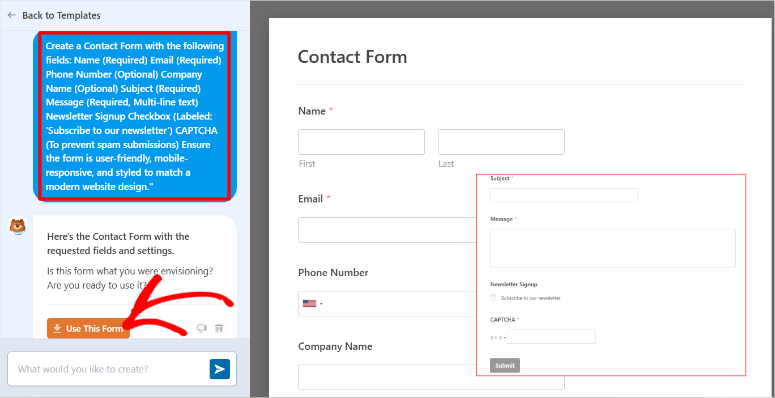

While building WordPress forms with AI is great, the Smart Workflow Automation is the feature that actually saves me valuable hours.
Instead of manually reading every form submission and deciding where it goes, WPForms automatically routes entries based on the content.
In this case, support requests go to my support team inbox, and sales inquiries land with the sales team.
While consultation requests get forwarded to the right department with all the details organized perfectly.
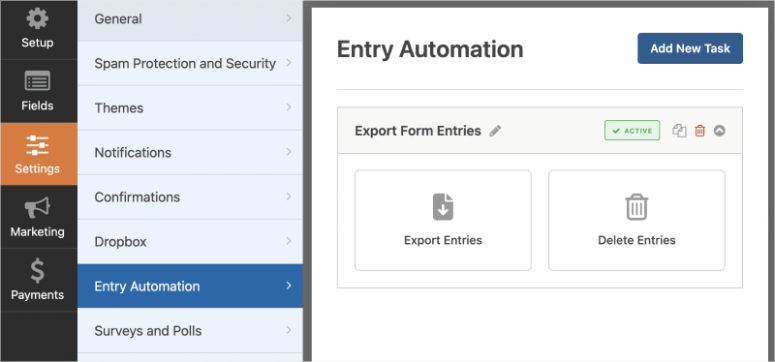

Apart from that, the Advanced Form Logic makes forms feel interactive rather than overwhelming.
Fields show and hide based on user responses, so people only see what’s relevant to them. If you couple this with the direct CRM integration you can sync form data automatically with Mailchimp, HubSpot, and 15+ other services.
No more exporting CSV files or copying data between systems.
With 2,000+ pre-built templates covering everything from event registrations to payment processing, you rarely need to build forms from scratch anymore.
Added to that, the drag and drop form builder handles complex multi-step forms that used to require custom coding.
►Pros:
- AI creates sophisticated forms through simple conversation prompts
- Smart workflow automation eliminates manual data sorting
- Direct CRM sync with 15+ popular marketing services
- Exceptional 5-star rating with genuinely beginner-friendly interface
►Cons:
- Pro features require $199/year for full automation capabilities
- Free version lacks conditional logic and advanced integrations
- Annual commitment only – no monthly payment options
- Basic plan limits templates to 6 vs. 2,000+ in higher tiers
My Verdict: If client communication and lead management eat up your time, WPForms transforms that chaos into organized automation. The AI form builder and smart routing make it perfect for service businesses that need professional client intake processes.
Check out my detailed WPForms review here.
Pricing: Free version available; Pro plans start at $49.50/year
4. WP Webhooks ⭐⭐⭐⭐⭐
Ultimate Integration Tool | Best for: Advanced users who need maximum flexibility
Pricing: Free version available; Pro plans start at $149/year


When I need to connect a WordPress site with a custom CRM that no other plugin supports, WP Webhooks always saves the day.
It’s like having a universal translator that lets WordPress talk to absolutely any web service. Think of webhooks as instant messengers between different websites and apps.
See, when something happens on your WordPress site, like a new user registration, WP Webhooks instantly sends that information to another service.
The magic is in its flexibility. If a service can receive web data, WP Webhooks can talk to it.
But I cannot mention WP Webhooks without talking about its Visual Flow Builder, which makes complex integrations surprisingly manageable.
Instead of writing code, you drag and drop actions to create multi-step workflows. Need to send new WooCommerce orders to three different systems? Just connect the dots visually.
What sets WP Webhooks apart is its comprehensive approach.
With 100+ WordPress plugin integrations and advanced data mapping tools, you can transform information to match exactly what each service expects.
Plus, the enterprise security features like IP whitelists and custom headers mean your automations stay secure.
►Pros:
- Unmatched flexibility connecting to virtually any web service
- Visual flow builder makes complex integrations manageable
- Outstanding user reviews praising reliability and capabilities
- Self-hosted solution with unlimited usage and complete data control
►Cons:
- Steeper learning curve for non-technical users despite visual interfaces
- Interface functional but lacks polish compared to consumer-focused tools
- Advanced features require understanding APIs and web service concepts
- Complex pricing structure with multiple tiers and site limits
My Verdict: Perfect for advanced users and developers who need to connect WordPress with custom systems or services that other plugins can’t reach. The ultimate flexibility comes with a learning curve, but the results are worth it.
Pricing: Free version available; Pro plans start at $149/year
5. Zapier ⭐⭐⭐⭐
8,000+ App Connections | Best for: Connecting WordPress with external tools
Pricing: Free version available; Pro plans start at $19.99/month


Zapier became essential when I realized most of my clients’ business tools lived outside WordPress.
While other plugins connect top WordPress plugins together, Zapier connects WordPress to the entire internet of business apps.
The beauty of Zapier is its massive integration library. With 8,000+ app connections, you can automate workflows between WordPress and practically any business tool you use.
New blog post published? Automatically share it on Twitter, add it to your email newsletter, and update your project management system.
Apart from that, the AI-powered Zap creation feature lets you describe workflows in plain language.
For example, you can tell it something like “when someone submits my contact form, add them to Mailchimp and create a task in Asana,” and it builds the automation for you.
But the reality about Zapier’s pricing model is that it scales quickly. You start with 100 free tasks per month, but complex workflows eat through tasks fast.
So a single multi-step automation can use 5-10 tasks, hitting limits quickly. As a result, I often look for Zapier alternatives when I want to keep a more client project cost-effective.
►Pros:
- Massive integration library with 8,000+ business apps
- No-code workflow creation with AI assistance
- Reliable performance with industry-leading uptime
- Scales from small businesses to enterprise-level automation
►Cons:
- Pricing jumps dramatically as task volume increases
- Complex workflows consume multiple tasks quickly
- Some WordPress features require additional plugins
- Heavy dependence on Zapier’s platform with limited export options
My Verdict: Essential if your business uses lots of non-WordPress tools, but watch the task usage carefully. Great for connecting WordPress to your broader business ecosystem, though costs can add up with heavy use.
Pricing: Free version available; Pro plans start at $19.99/month
6. All in One SEO ⭐⭐⭐⭐⭐
Smart SEO Automation | Best for: Automating SEO implementation
Pricing: Free version available; Pro plans start at $49.50/year


AIOSEO transformed my SEO workflow after I got tired of manually optimizing every single post and page. Now it handles the repetitive SEO tasks automatically while I focus on creating great content.
For starters, the Smart XML Sitemaps feature automatically generates and submits updated sitemaps whenever I publish new content. So, no more remembering to manually update Google Search Console.
On top of that, the TruSEO On-Page Analysis gives real-time optimization suggestions as I write, catching issues before they become problems.
What saves me the most time is the AI Content Generator. It automatically creates SEO titles, meta descriptions, and even FAQ sections based on my content.
Instead of spending 15 minutes crafting the perfect meta description for each post, I get AI-generated suggestions that I can use or refine.
The Internal Link Assistant is brilliant, too.
It automatically suggests relevant internal linking opportunities, helping boost SEO without the manual work of finding related posts.
Plus, the automated Schema markup ensures search engines understand my content better.
►Pros:
- Comprehensive SEO toolkit with advanced automation features
- User-friendly interface with clear optimization guidance
- Performance optimized code that doesn’t slow down websites
- AI-powered content generation for titles and meta descriptions
►Cons:
- Advanced automation features require paid plans starting at $49.60/year
- Higher memory usage compared to some lightweight SEO plugins
- Extensive feature set can overwhelm complete beginners initially
- Premium automation features locked behind higher-tier plans
My Verdict: Perfect for anyone who wants comprehensive SEO automation without technical complexity. The AI content generation and automated optimization suggestions make SEO implementation much faster and more consistent.
Check out the latest AIOSEO review here.
Pricing: Free version available; Pro plans start at $49.50/year
7. SeedProd ⭐⭐⭐⭐⭐
AI Website Builder + Lead Automation | Best for: Quick site building with automation
Pricing: Free version available; Pro plans start at $39.50/year


SeedProd is the best drag and drop page builder because it can help you create any page in minutes.
The AI Website Builder created a complete site with pages, and copy in just 60 seconds, something that used to take me a full day. That’s not all, SeedProd can also create AI images for your pages while it builds your site.
The real time-saver is how everything connects automatically.
You can connect the best email marketing tools like MailChimp, ActiveCampaign, and ConvertKit with just a few clicks.
While you can ensure lead capture forms automatically sync with your email lists, so new subscribers flow directly into your marketing workflows without manual imports.
I like how the drag and drop site builder eliminates theme conflicts entirely since it works independently of your WordPress theme.
Plus, with 200+ professionally designed templates covering various industries, you rarely start from scratch.
The automated page modes let you activate coming soon, maintenance, or 404 pages across your entire site with one click.
If you want to set up better converting landing pages, you can use the dynamic content management system.
It automatically updates pages based on user behavior and location, making each visitor’s experience more relevant without manual customization work.
►Pros:
- AI creates complete websites in 60 seconds with professional design
- No theme conflicts since it works independently of WordPress themes
- Built-in lead generation tools with automatic email marketing sync
- Performance optimized for fast loading and better conversion rates
►Cons:
- Less sophisticated workflow automation compared to dedicated automation tools
- Annual subscription required to maintain access to pro features
- Learning curve for advanced features like theme building
- Heavy reliance on SeedProd’s infrastructure and service continuity
My Verdict: SeedProd is great for small business owners and marketers who need professional pages quickly with basic automation. The AI builder and seamless email integrations make it perfect for rapid landing page creation and lead capture.
Check out my updated SeedProd review here.
Pricing: Free version available; Pro plans start at $39.50/year
8. Easy Digital Downloads ⭐⭐⭐⭐⭐
Complete eCommerce Automation | Best for: Digital product creators
Pricing: Free version available; Pro plans start at $99.50/year


Easy Digital Downloads, or EDD in short, eliminated the manual headache of running a digital product business.
Before EDD, I manually sent download links, tracked customer purchases, and managed subscription renewals.
The subscription billing automation handles recurring payments, renewal reminders, and subscription management automatically.
Now everything happens automatically while I focus on creating better products.
The automated file delivery system securely sends unique download links immediately after purchase, with no manual intervention required.
Then, the payment gateway automation handles Stripe, PayPal, and Apple Pay processing seamlessly.
All this happens while customer management automation creates accounts, tracks purchase history, and manages profiles without any manual data entry.
What makes Easy Digital Downloads special is complete data ownership.
By this, I mean no transaction fees like other platforms charge, and all customer information stays on your WordPress site.
At the end of the day, the detailed reporting system generates sales analytics and customer insights automatically. So, you always know how your business is performing without manual spreadsheet work.
►Pros:
- No transaction fees unlike platforms like Gumroad or Paddle
- Complete control over customer data and business information
- Unlimited scalability with no limits on products or transactions
- Extensive integration library with 100+ extensions for enhanced functionality
►Cons:
- Advanced automation features require paid extensions and plans
- Steeper learning curve compared to hosted solutions like Gumroad
- Self-hosted requirements mean you handle security and maintenance
- More initial setup time compared to plug-and-play alternatives
My Verdict: Perfect for digital product creators who want complete control over their eCommerce automation without ongoing transaction fees. The learning curve pays off with unlimited scaling and full data ownership.
Check out my Easy Digital Downloads review here.
Pricing: Free version available; Pro plans start at $99.50/year
That’s it for my list of the best WordPress automation plugins. But if you recall, I mentioned that I tested 23 tools. So, below, let us look at 5 automations that just missed the rankings.
Honorable Mentions: 5 More Automation WordPress Gems
WPConsent – Privacy Compliance Automation
WPConsent automatically handles the complex world of privacy compliance without legal headaches. It scans your site for cookies, categorizes them automatically, and blocks tracking scripts until users give consent.
The smart geolocation feature shows cookie banners only to visitors from regions that require them, like GDPR areas. While seamlessly integrating with your existing analytics and marketing tools.
WPConsent is perfect for businesses that need compliance automation without hiring privacy lawyers.
Check out my WPConsent review here.
Get Started with WPConsent here.
ClickSocial – Social Media Publishing Automation
ClickSocial is an excellent tool for any WordPress site because it automatically helps you post on social media. It has a Revival Post feature that automatically re-shares your older WordPress posts based on custom filters.
Apart from this, the one-click auto-publishing pushes new content across multiple platforms when you hit publish.
For better branding, the template-based system creates consistent social posts with dynamic variables. While the team collaboration features handle approval workflows automatically.
ClickSocial is ideal for content creators who want a social media presence without manual posting.
Check out my ClickSocial review here.
Get started with ClickSocial here.
OnePageGA – Analytics Dashboard Automation
OnePageGA automatically transforms confusing Google Analytics data into clear, actionable dashboards in under 20 seconds.
It automatically generates 25+ pre-made reports covering everything from traffic sources to conversion funnels, with real-time data processing that updates as new information comes in.
The smart metric prioritization automatically highlights what matters most for your business type. OnePageGA is perfect for business owners who need analytics insights without becoming data scientists.
Check out my detailed OnePageGA review here.
Get started with OnePageGA here.
WPCode – Code Management Automation
WPCode automates the tedious process of managing custom code snippets across WordPress sites. The smart conditional logic automatically loads code based on user roles, page types, or device types.
While the auto-insert feature places snippets at the best locations without conflicts. Apart from that, the code generator creates custom PHP, CSS, and JavaScript automatically using simple forms.
My favorite feature is the private cloud library, which syncs snippets across multiple sites with version control. This is essential for any agency managing multiple client sites.
Check out my WPCode review here.
Get Started with WPCode here.
TrustPulse – Social Proof Automation
TrustPulse is the best FOMO WordPress plugin. It automatically displays real-time social proof notifications to boost conversions without manual setup.
Apart from this, it tracks customer activity like purchases and signups automatically, then shows smart-targeted notifications to the right visitors at the best times.
Campaign automation integrates seamlessly with WordPress and WooCommerce, while built-in analytics automatically optimize notification timing and frequency based on performance data.
TrustPulse is perfect for eCommerce sites wanting to increase conversions through automated social proof.
Check out my TrustPulse review here.
Get started with TrustPulse here.
That is it for me. You now have a comprehensive list of the best automation plugins for WordPress. The only question left is how to choose the right automation plugin to meet your needs.
How to Choose the Right Automation Plugin
Picking the perfect automation plugin depends on what’s eating up most of your time right now. Here’s how to match your biggest pain points with the right solution:
- For connecting WordPress plugins together, start with Uncanny Automator if you want the easiest setup. Or AutomatorWP if you’re budget-conscious and don’t mind a steeper learning curve. Both handle internal WordPress automation beautifully.
- For client communication and lead management, WPForms dominates this space with AI form building and smart workflow automation. The automatic routing and CRM integration eliminate most manual client communication work.
- For SEO implementation, All in One SEO automates the repetitive SEO tasks that eat up hours. The AI content generation and automated optimization suggestions make SEO implementation consistent and fast.
- For external app integration, Zapier wins for connecting WordPress with business apps outside your website. While WP Webhooks handles advanced custom integrations that other tools can’t reach.
- For Quick Site Building, SeedProd‘s AI website builder creates professional pages faster than any manual approach, with built-in lead capture automation.
- For Digital Product Sales, Easy Digital Downloads automates the entire eCommerce process without transaction fees, giving you complete control over your digital product business.
By Skill Level:
By Budget:
- Free Options: All plugins offer free versions, but AutomatorWP and Uncanny Automator provide the most automation capability for free
- Best Value: AutomatorWP‘s modular pricing lets you pay only for features you need
- Premium Investment: WPForms and Uncanny Automator offer the most comprehensive automation for the price
That is it from me today! If anything is unclear, check out the commonly asked questions below.
FAQs: Best WordPress Automation Plugins
What’s the difference between Uncanny Automator and AutomatorWP?
Both handle WordPress automation excellently, but Uncanny Automator offers a more polished interface and better support, while AutomatorWP provides open-source flexibility and modular pricing. Choose Uncanny Automator for ease of use, AutomatorWP for customization and budget control.
Do I need coding skills for these automation plugins?
No coding required for any plugin on this list. They all use visual builders, drag-and-drop interfaces, or simple form-based setups. Even WP Webhooks, the most technical option, offers a visual flow builder for non-coders.
Which plugin saves the most time?
It depends on your biggest time sink. Uncanny Automator saves the most time if you’re manually managing users and plugin interactions. WPForms wins for client communication. All in One SEO dominates for content optimization. Start with whichever addresses your biggest daily frustration.
Can I use multiple automation plugins together?
Absolutely, and often recommended. Many users combine WPForms for client communication, Uncanny Automator for internal WordPress automation, and Zapier for external app connections. Just avoid overlapping functionality to prevent conflicts.
Are the free versions worth using?
Yes, especially for Uncanny Automator, AutomatorWP, and WPForms. The free versions provide substantial automation capabilities. Start free, identify your most valuable automations, then upgrade when you need advanced features.
How do I know if automation is working correctly?
All these plugins include logging and monitoring features. Check the automation logs regularly during your first week, then set up email notifications for failed automations. Most issues happen during initial setup, not ongoing operation.
Final Verdict: Are Automation Tools Worth It?
Absolutely. The time I’ve saved using these 8 plugins has been transformative. Tasks that used to eat up entire afternoons now happen automatically while I sleep.
But here’s the thing – automation isn’t about being lazy!
It’s about focusing on work that actually matters. Instead of spending two hours manually processing form submissions, I use that time to create better content or serve clients more effectively.
The math is simple. If WPForms saves me 5 hours per week on client communication, that’s 260 hours per year. At $50 per hour, the plugin pays for itself in the first week.
My advice is to start small. Pick the plugin that addresses your biggest daily frustration. Then, set up one simple automation, master it, and expand as you discover new opportunities.
If you are looking to automate even more in WordPress, check out this article on 7 Incredible Social Media Automation Tools.
If you are looking to automate beyond WordPress, check out this list of the best Zapier alternatives.
Now, here are more articles you may be interested in reading.
Ready to dive deeper into WordPress automation? These guides will help you master specific automation workflows and expand your toolkit even further.
منبع: https://www.isitwp.com/best-wordpress-automation-plugin/
